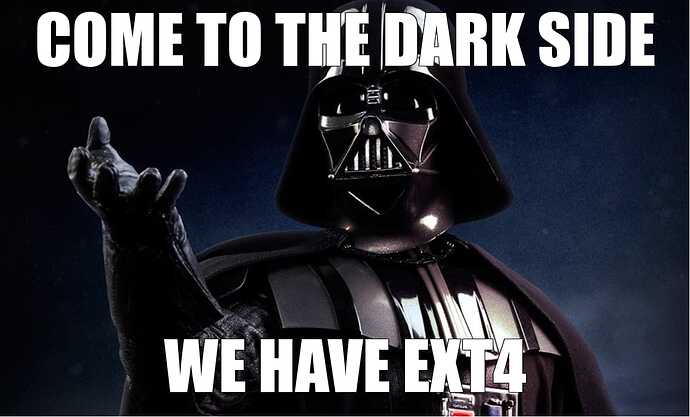Not sure this is where to ask, so apologies if it's not here.
Is BTRFS always the default FS for Garuda, regardless of where it is to be installed?
I ask, because according to:
[Samsung 870 QVO SSD Performance On Ubuntu Linux Review - Phoronix](https://Phoronix QVO 870 tests)
BTRFS, at least on this SATA SSD, is pretty poor.
I just bought a 4TB model and did a quick benchmark with KDiskMark to compare BTRFS and Ext4 on it (fresh formatted partitions), and the difference is quite significant in places:
KDiskMark (3.1.2): https://github.com/JonMagon/KDiskMark
Flexible I/O Tester (fio-3.33): https://github.com/axboe/fio
- MB/s = 1,000,000 bytes/s [SATA/600 = 600,000,000 bytes/s]
- KB = 1000 bytes, KiB = 1024 bytes
BTRFS
[Read]
Sequential 1 MiB (Q= 8, T= 1): 553.046 MB/s [ 540.1 IOPS] < 14765.52 us>
Sequential 1 MiB (Q= 1, T= 1): 378.640 MB/s [ 369.8 IOPS] < 2693.37 us>
Random 4 KiB (Q= 32, T= 1): 311.545 MB/s [ 77886.4 IOPS] < 412.92 us>
Random 4 KiB (Q= 1, T= 1): 10.129 MB/s [ 2532.4 IOPS] < 389.83 us>
[Write]
Sequential 1 MiB (Q= 8, T= 1): 512.920 MB/s [ 500.9 IOPS] < 14696.91 us>
Sequential 1 MiB (Q= 1, T= 1): 271.855 MB/s [ 265.5 IOPS] < 2582.10 us>
Random 4 KiB (Q= 32, T= 1): 158.610 MB/s [ 39652.5 IOPS] < 682.26 us>
Random 4 KiB (Q= 1, T= 1): 33.487 MB/s [ 8371.9 IOPS] < 80.16 us>
Ext4
[Read]
Sequential 1 MiB (Q= 8, T= 1): 549.381 MB/s [ 536.5 IOPS] < 14862.06 us>
Sequential 1 MiB (Q= 1, T= 1): 473.897 MB/s [ 462.8 IOPS] < 2151.70 us>
Random 4 KiB (Q= 32, T= 1): 352.906 MB/s [ 88226.7 IOPS] < 363.03 us>
Random 4 KiB (Q= 1, T= 1): 39.252 MB/s [ 9813.0 IOPS] < 100.66 us>
[Write]
Sequential 1 MiB (Q= 8, T= 1): 512.918 MB/s [ 500.9 IOPS] < 14804.80 us>
Sequential 1 MiB (Q= 1, T= 1): 301.143 MB/s [ 294.1 IOPS] < 2316.54 us>
Random 4 KiB (Q= 32, T= 1): 329.021 MB/s [ 82255.3 IOPS] < 386.49 us>
Random 4 KiB (Q= 1, T= 1): 58.388 MB/s [ 14597.1 IOPS] < 62.21 us>
Profile: Default
Test: 1 GiB (x3) [Measure: 5 sec / Interval: 5 sec]
Date: 2022-11-22 19:21:23
OS: garuda unknown [linux 6.0.9-zen1-1-zen]
I'm just wondering why there seems to be big differences, whether it is due to it being a SATA SSD, or the tech used in the drive?
